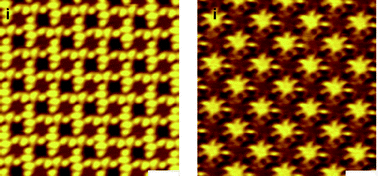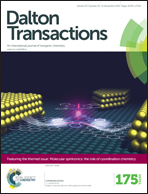A scanning tunneling microscopy study of the electronic and spin states of bis(phthalocyaninato)terbium(iii) (TbPc2) molecules on Ag(111)
Abstract
In this article, we investigate a single molecule magnet bis(phthalocyaninato)terbium(III) (TbPc2) molecule film by using low temperature STM. In order to investigate the effect of molecule–substrate interaction on the electronic and spin properties of the adsorbed molecule, we tune the molecule–substrate coupling by switching the substrate between Au(111) and Ag(111), the latter of which provides stronger interaction with the molecule than the former. Despite the enhanced chemical reactivity of the Ag(111) surface compared with Au(111), a well-organized pseudo-square film is formed. In addition, a checker-board type contrast variation is identified, which is well explained by the existence of two types of molecules whose rotational angle between the top and bottom Pc is θ = 45° (bright molecule) and θ = 30° (dark molecule). The expected stronger molecule–substrate interaction, however, appears as an intriguing dI/dV mapping image which reveals the spatial distribution of the density of states (DOS). We identify the contrast reversal in the dI/dV mapping for the molecules of θ = 45° and θ = 30° at the sample voltages of V = 0.7 eV and 1.1 eV. Combined with the density functional theory (DFT) calculation, we attribute this change to the shift of an electronic state due to the rotation of the mutual angle between the top and bottom Pc. For the spin behavior, we previously observed a Kondo resonance for the TbPc2 molecule adsorbed on the Au(111) surface. On the Ag(111) surface, the Kondo resonance is hardly observed, which is due to the annihilation of the π radical spin by the charge transfer from the substrate to the molecule. Instead we observe a Kondo peak for the molecule on the second layer, for which the spin recovers due to the reduction of the coupling with the substrate. In addition, when a magnetic field of 2 T normal to the surface is applied, the second layer molecule shows a sharp dip at the Fermi level. We attribute this to the inelastic tunneling feature caused by the spin flipping. This feature is not observed for the TbPc2/Au(111) system, suggesting that the decoupling between the TbPc2 molecule and Ag(111) by the presence of the first layer produces an inelastic feature in the tunneling spectra.

- This article is part of the themed collection: Molecular Spintronics : The role of Coordination Chemistry

 Please wait while we load your content...
Please wait while we load your content...